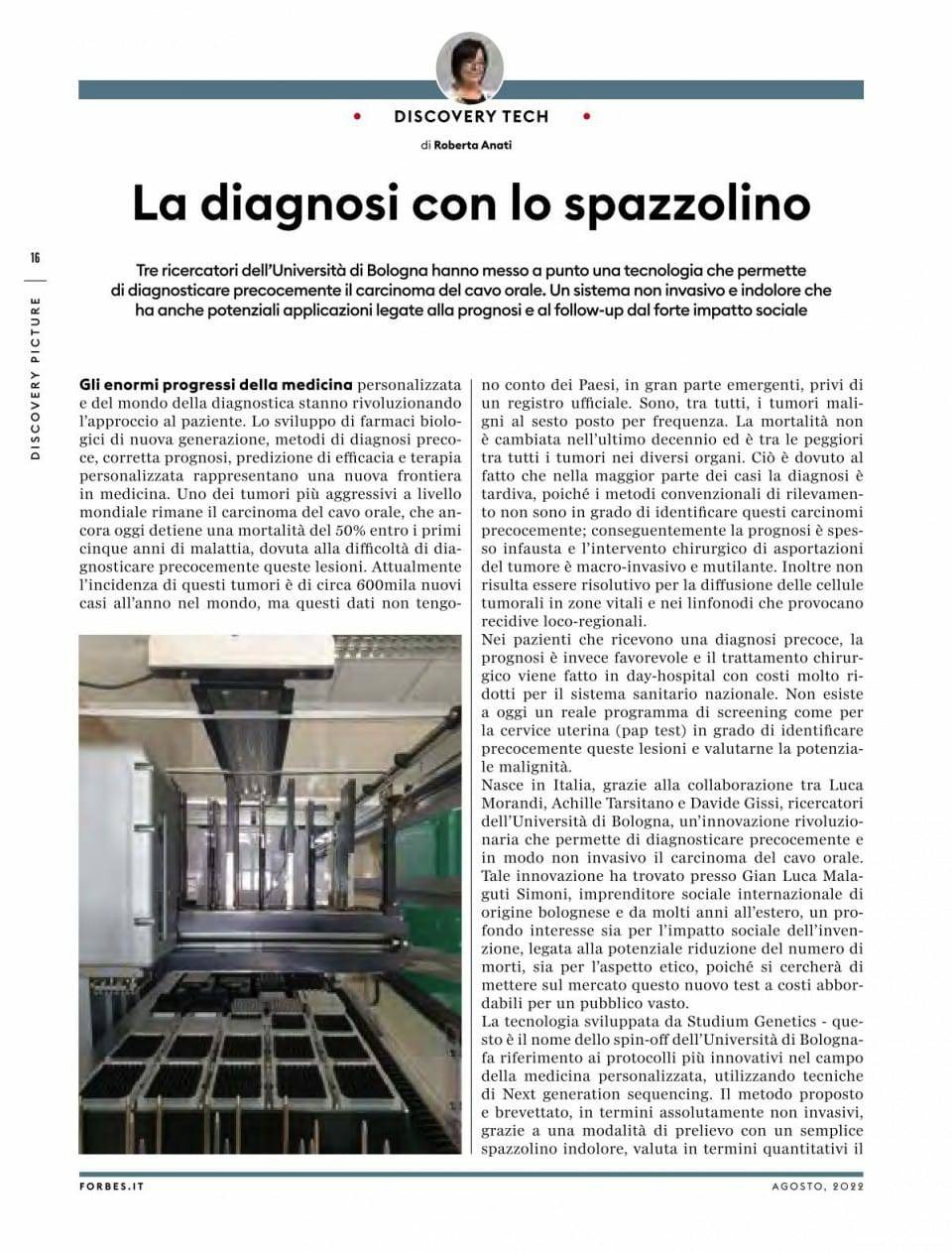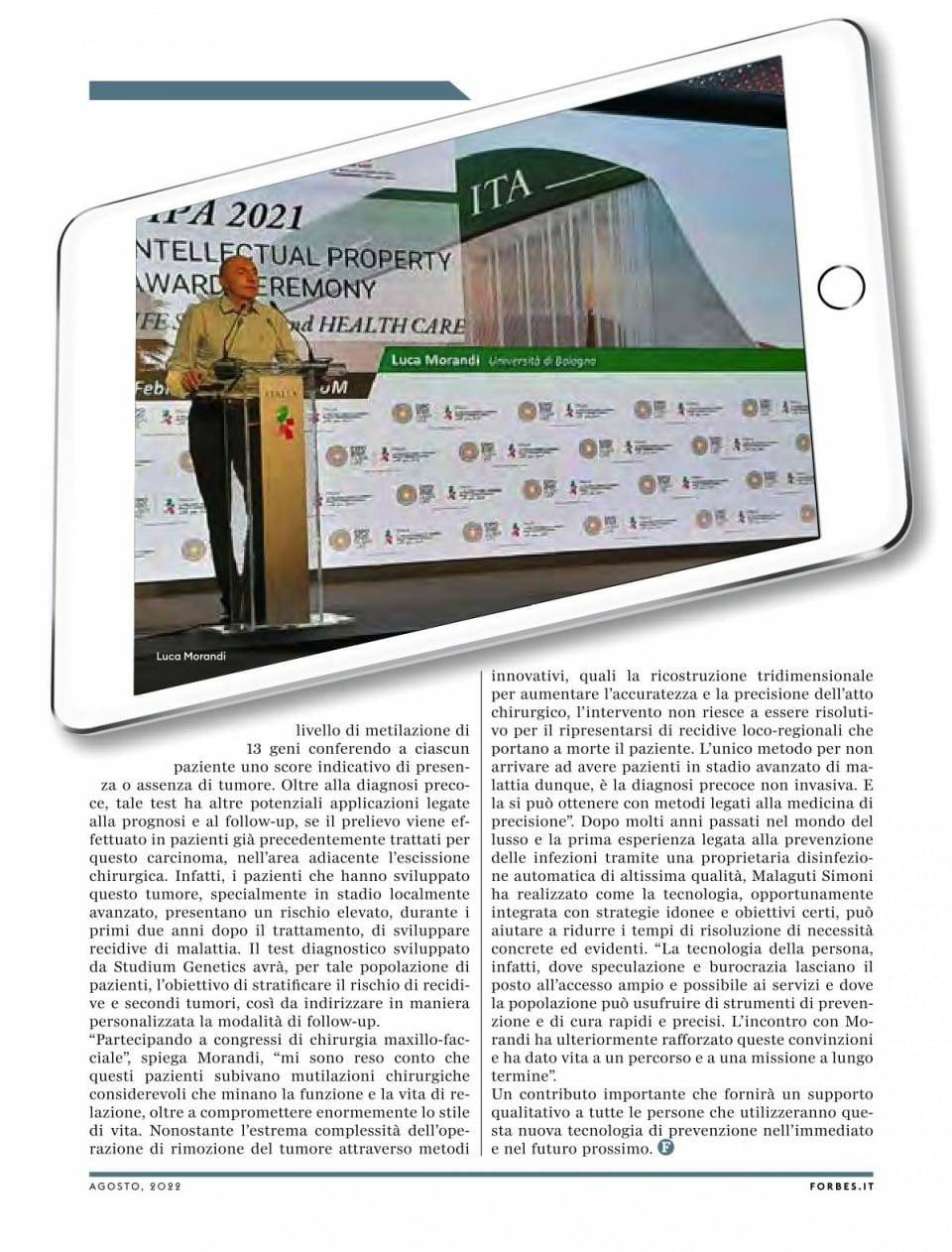Diagnosis with a little brush
“Three researchers from the University of Bologna have developed a technology that enables early diagnosis of oral cancer. A noninvasive and painless system that also has potential applications related to prognosis and follow-up with a strong social impact.
– Forbes, Italian edition, August 2022

Great advances in personalized medicine are revolutionizing the approach to the patient. In particular, the development of next-generation drugs, methods of early diagnosis, correct prognosis, prediction of efficacy, and personalized therapy represent a new frontier in medicine.
Oral carcinoma remains one of the most aggressive cancers worldwide, with a 50% mortality rate within the first 5 years of disease due to the difficulty of diagnosing these lesions early.
Currently the incidence of these cancers is about 600,000 new cases per year worldwide, the sixth ranked by frequency among all malignancies. But these figures do not take into account those countries in the emerging world without an official registry.

Risk factors are related to smoking, alcohol intake, and in oropharyngeal carcinomas to HPV infection. Mortality has not changed in the last decade and is among the worst of all cancers in the different organs. This is due to the fact that in most cases the diagnosis arrives too late, as conventional detection methods cannot identify these carcinomas early. Consequently, the prognosis is often inauspicious, and surgery to remove the tumor is macro-invasive and mutilating. Moreover, the intervention is often not sufficient, because of the spread of cancer cells to vital areas and lymph nodes, which cause loco-regional recurrences. In patients who receive early diagnosis, on the other hand, the prognosis is favorable and surgical treatment is done in Day-Hospital with much reduced cost to the national health care system.
It is apparent that proper early diagnosis would decrease mortality and greatly reduce the cost to the National Health Service of treating these patients.
To date, there is no real screening program as for the cervix (pap test) that can identify these lesions early and assess their potential malignancy. In current clinical practice, identification of oral carcinomas is done only by visual inspection by the dentist or maxillofacial surgeon, or by the otolaryngologist. In the case of suspicious lesions, a biopsy is performed, often poorly tolerated by the patient, to get a histologic report of dysplasia or carcinoma. These lesions are not always clearly visible macroscopically because of their subtle nature, and often the limited experience of the health professionals does not allow these carcinomas to be identified in their early stages.
A revolutionary innovation
A revolutionary innovation was born in Italy, thanks to the collaboration between Dr Luca Morandi, Dr Achille Tarsitano and Dr Davide Gissi, researchers at the University of Bologna, that allows early and noninvasive diagnosis of oral cavity carcinoma. This patented innovation and its potential for reduction of the number of deaths has met the interest of Gian Luca Malaguti Simoni, an international social entrepreneur of Bolognese origin who has been abroad for many years. Studium Genetics was founded as a spin-off company of the University of Bologna to bring this new test to the market at an affordable cost for a wide audience.
The technology developed by Studium Genetics refers to the most innovative protocols in the field of personalized medicine using Next Generation Sequencing techniques.
The patented method, in absolutely non-invasive terms thanks to a painless toothbrush sampling mode, quantitatively assesses the methylation level of 13 genes, giving each patient a score indicative of the presence or absence of cancer.

Prognosis and follow-up
In addition to early diagnosis, this test has other potential applications related to prognosis and follow-up if the sampling is performed in patients previously treated for this carcinoma, in the area adjacent to surgical excision. In fact, patients who have developed this tumor, especially at a locally advanced stage, have a high risk, during the first two years after treatment, of developing disease recurrence. The diagnostic test developed by Studium Genetics will have for such a patient population the goal of stratifying the risk of recurrence and second tumors, so as to individually target the follow-up modality.
"Attending maxillofacial surgery conferences," Morandi explains, "I realized that these patients were undergoing considerable surgical mutilation that undermines function and relationship life, as well as greatly compromises lifestyle. Despite the extreme complexity of the operation to remove the tumor through extremely innovative methods such as three-dimensional reconstruction to increase the accuracy and precision of the surgical act, the surgery fails to be decisive because of the recurrence of loco-regional recurrences that lead to the patient's death. The only method of not getting to advanced stage of disease patients is noninvasive early diagnosis. And it can be achieved by methods related to precision medicine.
After many years spent in the luxury goods sector and a first experience related to infection prevention through a proprietary automatic disinfection of the highest quality, Malaguti Simoni realized how technology, properly integrated with suitable strategies and certain goals, can help reduce the time to solve concrete and obvious needs. "It's a technology focused on the person, where speculation and bureaucracy give way to broadening the access to services and where the population can take advantage of fast and accurate prevention and treatment tools. The meeting with Morandi has further strengthened these convictions and created a long-term path and mission."
It is an important contribution that will provide qualitative support to all people who will use this new prevention technology in the immediate and near future.
[Originally published as “La diagnosi con lo spazzolino”, by Roberta Anati, Forbes Italia, August 2022, translated and edited with permission]
